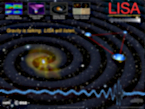http://en.wikipedia.org/wiki/Laser_Interferometer_Space_Antenna wrote:
<<The Laser Interferometer Space Antenna (LISA) is a planned space mission to detect and accurately measure gravitational waves from astronomical sources.
LISA was recommended in the 2010 U.S. National Research Council decadal report on astronomy and astrophysics as one of two large space missions to be implemented by NASA in the upcoming decade. The report recommends that LISA start in 2016, after a successful LISA Pathfinder flight and selection in the ESA Cosmic Vision program, which would then enable launch in 2025.
LISA will be the first dedicated space-based gravitational-wave detector; it will measure gravitational waves by using laser interferometry to monitor the fluctuations in the relative distances between three spacecraft, arranged in an equilateral triangle with 5-million-kilometer arms, and flying along an Earth-like heliocentric orbit. Passing gravitational waves create oscillations in the inter-spacecraft distances, as measured by light, in directions transverse to the direction of wave propagation.
LISA will be sensitive to waves in the frequency band between 0.03 milliHertz to 0.1 Hertz, including signals from massive black holes that merge at the center of galaxies, or that consume smaller compact objects; from binaries of compact stars in our Galaxy; and possibly from other sources of cosmological origin, such as the very early phase of the Big Bang, and speculative astrophysical objects like cosmic strings and domain boundaries.
Each of the LISA spacecraft contains two telescopes, two lasers and two test masses, arranged in two optical assemblies pointed at the other two spacecraft. This forms three Michelson-like interferometers, each centered on one of the spacecraft, with the platinum-gold test masses defining the ends of the arms. The entire arrangement, which is ten times larger than the orbit of the Moon, will be placed in solar orbit at the same distance from the Sun as the Earth, but trailing the Earth by 20 degrees, and with its orbital plane tilted relative to the ecliptic by 60 degrees. The mean linear distance between the constellation and the Earth will be 50 million kilometers.
To eliminate non-gravitational forces such as light pressure and solar wind on the test masses, each spacecraft is constructed as a zero-drag satellite, and effectively floats around the masses, using capacitive sensing to determine their position relative to the spacecraft, and very precise thrusters to keep itself centered around them. This technology was pioneered by the TRIAD satellite in 1972. A single satellite ("LISA Pathfinder"), to be launched in 2013, will test drag-free operation as it will be implemented in LISA.
The main goal of LISA is to use direct measurements of gravitational waves to study astrophysical systems and to test Einstein's theory of gravity. The existence of gravitational waves is inferred from observations of the decreasing orbital periods of several binary pulsars, such as the famous PSR 1913+16. However, gravitational waves have not yet been directly detected on Earth because of their extremely small effect on matter. Observing them requires two things: a very strong source of gravitational waves – such as the merger of two black holes – and extremely high detection sensitivity.
The LISA instrument should be able to measure relative displacements with a resolution of 20 picometers over a distance of 5 million kilometers, yielding a strain sensitivity of better than 1 part in 1020. Thanks to its sensitivity in the low-frequency band of the gravitational-wave spectrum, LISA will detect waves generated by binaries within our Galaxy (the Milky Way) and by massive black holes in distant galaxies.
Ground-based detectors like the Laser Interferometer Gravitational-Wave Observatory (LIGO) seek to detect high-frequency gravitational waves from stellar-sized systems, such as spinning neutron stars, supernovae, and the final minutes of the gravitationally-driven in-spiral of neutron stars and black holes. By contrast, LISA will observe lower frequency waves from larger or more massive systems, such as compact-object binaries with large orbital separations, and supermassive black-hole binaries in the final months of coalescence.
Previous searches for gravitational waves in space were conducted for short periods by planetary missions that had other primary science objectives (such as Cassini–Huygens), using microwave Doppler tracking to monitor fluctuations in the Earth-spacecraft distance. By contrast, LISA is a dedicated mission that will use laser interferometry to achieve a much higher sensitivity. Other gravitational wave antennas, such as LIGO, VIRGO, and GEO 600, are already in operation on Earth, but their sensitivity at low frequencies is limited by the largest practical arm lengths, by seismic noise, and by interference from nearby moving masses. Thus, LISA and ground detectors are complementary rather than competitive, much like astronomical observatories in different electromagnetic bands (e.g., ultraviolet and infrared).>>
 HEAPOW: Silver Surfers of Spacetime (2010 Sep 20)
HEAPOW: Silver Surfers of Spacetime (2010 Sep 20)
